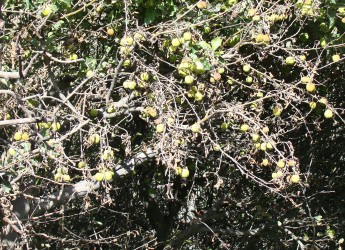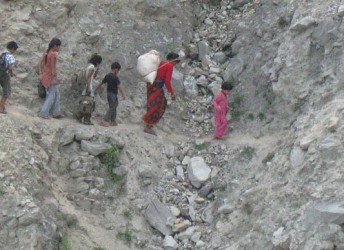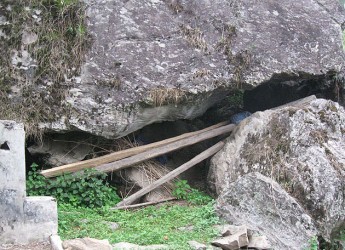I wrote about how climate change is affecting Nepal a few weeks ago, when I was lamenting that the monsoon was late and then, again lamenting (!) that the rains had finally arrived – too late for a lot of the rice to be planted, and causing chaos and misery due to flooding and landslides.

It seems that everywhere I look at the moment I am hearing stories about how climate change is affecting people’s lives here – in really tangible ways. The Nepali Constituent Assembly Member, Sunil Pant, recently led a cross party mission of MPs to the district of Mustang, in Nepal’s Himalayan region. There the MPs saw and heard evidence that the communities were finding hard to manage changing weather patterns, growing incidence of extreme weather events such as frequent droughts and floods, break out of crop diseases, livestock diseases and conflicts over sharing scarce water. A lot of people are now aware that the glaciers are melting, but for example, the apple farms in Mustang are being devastated as warmer and drier winters and high temperatures have meant that the quantity and quality of apple productivity has gone down; the houses are made with clay roofs, which should be able to withstand snowfall, but are not designed to withstand the heavy rains the villagers are now experiencing; and goats and some traditional crops are dying due to new kinds of diseases (see photo) that the farmers haven’t seen before and are attributing to the changing seasons.

But it’s not just in Mustang that climate change is being felt – it’s all over Nepal. Pasang Tamang, has spent 50 years of his life in Ward Number 4 of Bhorle Village in the Rasuwa District. According to Pasang, the temperature has definitely increased. Papaya never used to grow in his yard but now it bears fruit. A local flower, Aaru, used to bloom in March but now it blooms much earlier, starting in December/January, similarly, another local plant, the Shorea robusta (I don’t know the Nepali name) has started shedding leaves much earlier than before. Pasang is also worried because landslides have already destroyed 13 of the 15 water mills in the Ghatte River, the river that borders ward 1 and 4 of Bhorle. And again, stories of increased instances of diseases, this time in people – according to Pasang diseases such as jaundice, which were unknown to him and his folks in the village until a few years ago, now seem to be spreading rapidly.
Now I’m no expert, but something bad is going on – directly affecting people’s lives - and climate change seems the most likely reason. It must be pretty scary when seasons and patterns that you have lived with all your life (and for generations before you) suddenly start changing in a few short years. This is why we are trying to do what we can in Nepal to help people adapt to climate change, so that they can at best live with, and perhaps even benefit from, these strange changes that are happening in their villages.
This blog features as part of Blog Action Day and the Act on Copenhagen campaign





9 comments
Comment by Mochi Sada posted on
Dear Sarah Ji,
It seems you always catch the problem correctly but you always suggest measures for solution incorrectly. You suggest Nepali people to adapt to climate change....... finish. I understood now why green peace workers climbed on your parliament building and flaged disatisfaction on your climate change policy.
It is true Nepali people should be taught first on how to adapt climate change. But this is not the complete solution as you know. My question is you don't see your countries' role behind this terrible result? You don't see Nepali policy makers' crime toward the poor indigenous Nepali people?
The need is to think first on underlying causes of this result. Try to be honest and you will find yourself as guilty person. Just review your work in Nepal. Is your so called successful community forestry program successful and helping in preserving climate? or becoming heaven for wood smuggler? or becoming tool for displacement of original inhabitants or indigenous peoples? Is your agriculture program beneficial to poor farmers or it is tool for creating corrupted government beurocracy? Do you know your governance programs are creating additional beurocracy and corruption in government sector? You should be aware that all these things are affecting adversely on climate change in Nepal.
Your final thinking in your article leads toward one new sector for Nepalese traditional elite to beg from donors. Congratualtion for innovative consumption idea of British pound! You need papers, datas, technical views, professional manners, specialized expertise, reports and complete Nepali type devotion towards British babugiri. You can get these from Nepalese Bahuns and Gurkhas. Don't mercy on most marginalized indigenous peoples, Dalits, Muslims, Madhesi and thier womens.
Congratualtion!
Comment by CivicSurf » Blog Action Day: Climate Change blogging posted on
[...] the Climate Change group that are contributing to Blog Action Day. Already Sarah Sanyahumbi has posted about late monsoons in Nepal and Neil Squires reflects on how the floods in 2000 that left much of Mozambique underwater make [...]
Comment by raffa's status on Thursday, 15-Oct-09 13:32:38 UTC - Identi.ca posted on
[...] http://dfid.blog.gov.uk/2009/10/nepals-strange-changes-in-climate/ a few seconds ago from firestatus [...]
Comment by Sarah Sanyahumbi posted on
Dear Mochi
I've been away so just seen your comments. I think you have a fundamental misunderstanding of the work we are trying to do here in Nepal! Let me try and explain.
We understand fully that Nepal is not among the countries who have exploited the environment but the vulnerability is high. Adaptation must be the priority for least developed countries like Nepal and it has been recognized and appreciated in the United Nations Framework Convention on Climate Change and Bali Action Plan. The UK is strongly supporting adaptation work in Nepal. UK government has recognized the spirit of United Nations Framework Convention on Climate change, Kyoto Protocol and other agrements and negotiations on climate change emphasizing on principles like 'common but differentiated responsibilities' and polluters pay. The UK government has provided global financial and technical support to help the vulnerable countries and also shown its future commitments in substantial emission reduction and financial commitment for adaptation. The UK government is also lobbying to secure a global deal that will enable developing countreis to grow in a climate smart way and to help the poorest people prepare for climate change. In Nepal we are committed to supporting the most vulnerable communities through our financial commitment of 10 million pounds over next 5 years.
Finally, DFID’s Livelihood and Forests Programme currently works in 15 districts, including in three districts in the Terai region, and to date has lifted 100,000 people living in forest communities out of poverty. It is very popular with communities and we plan to spend an extra £40m over the next 10 years to protect Nepal’s forests and improve the lives of the people living in them. Perhaps you could visit some of these communities to find out how this programme has empowered them and really helped them to positively transform their lives. We would be interested to hear your views - We welcome constructive feedback on our programmes.
Thank you for the interest in this blog - it is good to see it has raised some discussion!
Sarah
Comment by Basanta posted on
Dear Sarah
I am happy to read your article about climate change. You raised very important issues in the Nepal Himalaya. I have been working in Mustang district starting from Lete to Lomangthang. Although, I am studying in Paleoclimate of that area. I saw so many changed in these recent years. Apple farms are dying and their lifestyle are changing. People are afraid of climate change and all the people including INGOs and govermental officers are only talking and talking. There are no proper research data on how climate change affect the people. There is research data gap. How can we predict the future climate change if we don't have past climate change record. Glaciers are melting and GLOF affecting all the people down the valley. We will do action after the accident. I hope DFID will work on that aspect also.
Many thanks
Basanta
Comment by Mochi Sada posted on
Dear Sarah,
All know, Britain still lag far behind in achieving set target in emission reduction. As far as the debate about polluters pay responsibility, developed countries are not taking it as their natural responsibility. They are linking it with politics and trade. So, how are you making justice with least developed countries, which are identified as less polluters?
Anyway, you are confident about your work in community forestry sector in Nepal. I request you to just think on these aspects without being bias to any particular side.
- What are the negative sides of community forestry programme in Nepal?
- Who are mostly benefited from this programme?
- Traditional forest users of Terai are prohibited or not to access in Churia forest?
- Who holds the key and decision making positions of CFUG?
- What is the use of forest income?
Dear Sarah, you will find your so called most successful community forestry programme doesn't respect ILO 169 and UNDRIP which ensures indigenous rights over natural resources. On the other hand, Nepal government has ratified these two international instruments and it is also incorporating the provisions of these two in new constitution (in principal). This means you are fueling conflict among communities of Nepal through your forest programme.
The second thing is your programme has mostly benefited Bahun and Chhetris who are mostly at the top of the hierarchical order of CFUG. This means traditional access and control of local inhabitants are very tactfully shifted to dominant communities through your forest programme. This is another promotional act for conflict.
And finally, I suggest and challenge you to carry out a study and find out what happens to the income of CFUG. My forecast is you will find most of the resources are used for political (party) activities and local infrastructures building which promotes Hinduism at local level i. e. temple, Chautara and other feudalistic activities, not in improving livelihood of poor and excluded as you think.
So, I don't think your forestry programme is massively contributing in poverty reduction. Obviously, there are some success examples with you. But this doesn’t mean that your forestry programme is successful in every aspect. This is also producing negative results which should be assessed without any bias.
If you believe in healthy discussion, then try to listen opposite voice also. If not, it is up to you.
Comment by Basanta Raj Adhikari posted on
Dear Mochi
Thank you for nice reply. Although, you are replying to Sarah but i want to put some my words for your reply as well.
Community forestry program is doing best in Nepal and it is a best practice upto now. I am totally agree on your points about the user groups. Yes, most of Bharmin and Chhetris are using these CF but don't forget that there are lots of other casts who are using besides Bharmin and Cheetries. I don't know you personally but from your reply, I can say that you know about the social system in Nepal and recent changing in social system. Now, every people from the different casts have access for the resources.
I totally disagree from your point that it is promoting for the Hinduism because it is good to make Temple and Chautara. They are necessary things for the society and how can you say that it is only related to the religion. In community forestry, there are different people from different religion. Chautara is common place and anyone can sit there and take enjoy. Its not only religious place. I hope, you understand.
For the poverty reduction, CF is helping to poor people for managing their daily life by providing wood, grass for animals. We can improve our knowledge on Carbon trading from this program also.
Yes, there is always good and bad aspect of every program. I think, we have to look on the positive side and we have to go on that direction. But, we don't have to forget the negative aspect also because we can improve that side also.
Many Thanks
Basanta Raj Adhikari
Comment by Sushil Sharma posted on
I would like to request you Sarah to kindly read the article of Former Foreign Minister Ramesh Nath Pandey in last week's Kantipur daily. I am sure you have translators in the office. Its an excellent piece on Nepal's issues vis-a-vis the climate change and the Copenhegen meet.
Comment by Giri Raj Khatri posted on
Dear all
It's very nice to read this coment. But before talking about adapatation we need to know the local perception on climate change. There are several pertinent questions such as Do local perception has any significance? How valid and reliable are their observation?